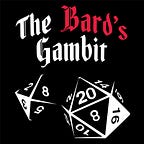PTSD and Panic in Entertainment, Part 2
In December, I wrote the first part of this article ( https://medium.com/collected-blog-posts-of-a-bipolar-author/ptsd-and-panic-in-entertainment-262950fb1524), and I’d like to come back to that now that some personal things have finally settled down. Once again, this article will have spoilers for Fun City Episode 8, so I ask that you watch that before you read this (https://open.spotify.com/show/2jY373yuXkXyHV1ZOpcint?si=wzusr6gkThOKfx1rR560pQ)
So last time we talked about an instance of PTSD portrayed respectfully, but that was about an NPC. While the NPC was a major part of the narrative, it was something that was easily planned in advance as part of the character. That isn’t a bad thing. It made for a compelling moment in the narrative, and makes it much easier to handle the delicate topic the character is being used to explore. However, being an NPC causes a perspective shift, and by extension a shift in listener values. Listeners are looking at the experience from the outside, a perspective that promotes sympathy for the character but makes empathy difficult for people who haven’t been in the NPC’s place in the past. Which is why the next scene is incredibly valuable.
After the Solix is taken from the scene by his guards, the players leave the corridor and go back out into the riot in an attempt to escape the area. During their flight, they are attacked by a handful of police who had decided they looked suspicious and should be arrested. In the beginning of the ensuing battle, Cairne, one of the enemies casts a spell called Chaos on Viv (played by Jenn De La Vega) that causes her to be… distracted. As described by Taylor Moore, “Cairne magnifies the Chaos thats already in the room. So Viv is going to see objects flying at her head, she’s gonna see strangers running toward her and diving at her. It magnifies the riot.” Paired with this description, the riot sound effects slowly build in volume. It is always low enough that the listeners can still hear the story being told, but the effect is still palpable.
Viv has plenty of goofy moments in there series so far, but she is generally portrayed as a serious and collected character. With that in mind, it becomes a shock when she begins to break down during the experience. She stumbles, she starts crying, and then she violently lashes out at the source of the chaos with everything she has, murdering Cairne. The players have a bit of jovial banter before the GM describes the horrific effects of the attack. While it is a gruesome scene, we only care about it as an aspect of Viv’s reaction, so I won’t describe it here.
The way this scene was handled is… intense. I know I mentioned this at the top of the article, but you really should go listen to it for yourself to get the full effect. Because of the shift in narrative perspective, listeners are trapped inside of Viv’s head as she experiences what is essentially a panic attack brought on by sensory overload. The rising chaos of the sound effects, combined with Taylor’s description of the scene and Jenn De Le Vega’s (Viv’s player) description of Viv’s reaction and headspace while it’s happening, forces listeners to experience the scene alongside Viv (albeit from a safe space). This contrasts starkly with the Solix’s scene, where the narrative perspective places the listeners as onlookers to someone else’s reaction. This new perspective completely changes the listener’s priorities from empathy to sympathy in a way that would be difficult to do from the eyes of an onlooker.
Anyone who has to deal with sensory overload knows this scene. Maybe not the specific situation or the… murder, but the rising panic as sounds and movement overwhelm the senses is well known among people with various neuro-divergent characteristics. It can be a traumatic experience for people, and this is an opportunity to understand how and why for those who have never dealt with it before. In this safe space, the players’ reactions to the scene also helps to contextualize peoples’ feelings. Jenn’s reaction we get through Viv’s actions, while everything from “Fuck that Guy” to “OH SHIT” on display from the rest of the cast. When asked why everyone was so happy Viv’s target was so gruesomely killed, Shannon Odell responds, “He hurt her! He made Viv cry!” in a voice that sounds audibly upset. It’s apparent that, while everyone at the table is still laughing and enjoying themselves, the scene has had a strong effect on them.
It can be hard to grapple with PTSD and Panic in other people when you haven’t experienced those issues yourself. Without a basis of reference for their effects, it can be easy to write off the actions of people experiencing them as irrational. After all, it’s just a bad memory, or some loud noise, a crowd. People deal with those all of the time, so someone who has a panic attack or PTSD episode must be overreacting or making it up. But these experiences can be crippling to those who have to live with them. However, media like this can give people a reference point, if they allow it. When handled with respect, Media can give neuro-typical people an important opportunity to understand and sympathize with the neuro-divergent.
So thank you, Fun City Ventures, for handling these characters and their issues with respect and dignity.
